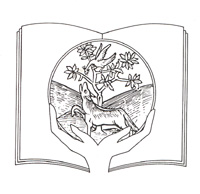





 |
 |
 |
 |
 |
|||

|
|||||||

The
Society's logo (1986-1997), originally designed for its jubilee year 1986,
which |
|
|
The first issue of The Journal of the Society for the History of Natural History, 17 October 1936.
|
At the establishment of the Society the emphasis on the dating of books which contained scientific names set one of the interests of the Society and its members which has continued until the present, although with decreasing emphasis. Another topic was defining the issue of what constitutes publication and this has recurred as a point for discussion over the years until very recently with development of modern technology enabling the replication of multiple identical copies both quickly and cheaply. Establishing the dates of publication of books in natural history in which scientific names were published still continues to be of interest partly because so many books in natural history were published in parts in the eighteenth and nineteenth centuries (with the title page issued with the last part to be printed and thus possibly bearing a date some time after the date when the names were actually available). Also in this period many natural history books were published with very small print runs and were genuinely very rare books. In response to this rarity the Society in its early days published a number of facsimile reprints of rare books so that naturalists and librarians were able to purchase copies of these papers and consult the original texts in facsimile. However, the principal object of the Society was the establishment of a serial publication which would publish papers devoted to natural history bibliography in its widest sense. In the early days the first part of each volume was devoted in whole or in part to a catalogue of papers concerning the dates of publication of natural history books, which was the result of a planned series arising from a “card index” of such papers which would be submitted by members for publication. The timing of the first publication of The Journal of the Society for the Bibliography of Natural History in October 1936 was unfortunate, because within three years, much of the world was plunged into war and shortages of paper amongst other commodities posed a threat to its survival. Despite this the production of 12 parts of the Journal totalling 504 pages completing the first volume was a remarkable achievement by February 1943 (although the publication rate was much less in the next few years). |
| During the post-war period the Society’s activities continued at a low level but by the 1970s there were a number of new members in the Society and a general eagerness to regenerate its activities. The Society had always been active in producing facsimiles of rare works which were published in the Journal and this activity on a larger scale seemed to offer an under-exploited field and it was resolved to produce larger works by facsimile. The first free-standing facsimile produced was the Essai sur la geographie des plantes by Alexander von Humboldt (1807) reproduced in 1959 which was unfortunately issued without the introductory essay by W.T. Stearn which appeared in the Journal of October 1960. This facsimile was produced partly using a small sum of money left to the Society by C.D. Sherborn, its first President. For this reason the series of facsimiles were named the Sherborn Fund Facsimiles. Subsequent facsimiles in the series were the Zoological researches, and illustrations; or natural history of nondescript or imperfectly known animals by John Vaughan Thompson (1828-1834) in 1968, and Questions about the breeding of animals by Charles Darwin (1840) and Brief instructions for making observations in all parts of the world by John Woodward (1696) both published in 1973. No further facsimiles were published and the series is now discontinued. Between the initial planning to publish facsimile reproductions in 1936 and their production by the Society, the world of facsimile publication had totally changed and the Society lacked the financial resources to tackle the rarer and larger works which were mostly what remained to be reproduced. |
|
The Society’s Sherborn Fund Facsimile of Humboldt’s Essai is still in print. |
The name both of the Society and its journal came under scrutiny on the grounds that both names were inconveniently long and unwieldy in a period when a more modern image was sought for the purposes of publishing the Society’s objects. This difficulty was discussed informally and formally and, in October 1979, it was decided to rename the Society The Society for the History of Natural History and to adopt a new title for the journal – the Archives of natural history. At first the newly titled journal was published as two parts a year, but later it became a regular three parts with about 424 pages annually. Papers published in the Archives cover all disciplines in the earth and life sciences and are concerned with the publishing history of many well-known books and the lives of naturalists and their books. Historical studies have largely replaced bibliography, although some papers still concentrate on the date of publication of scarce books. All papers are refereed. The Society has an international membership and regularly arranges meetings and conferences. Where there are sufficient members to attract an audience, informal local meetings are held. International conferences are arranged every two years on a particular theme; they have mostly been held in the United Kingdom and the annual business meeting is part of the agenda. Alwyne Wheeler |
 |
[TOP] • Home • About SHNH • Publications • Meetings • How to Join • News • Links • Site Map |